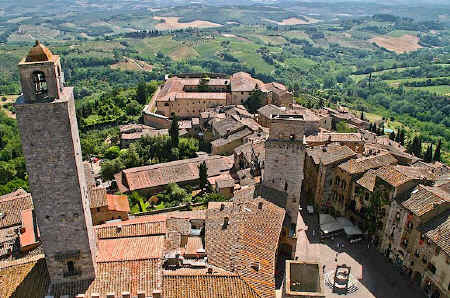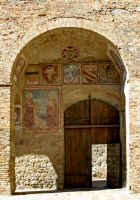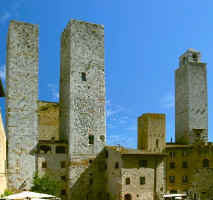San Gimignano from mediaeval timesThe territory of San Gimignano covers 138 sq km, spread over the hills of the Val d’Elsa in Tuscany, Italy. San Gimignano first appears in the historical record as a village on the Via Francigena, then later in history as a castle, a free municipality, and finally the seat of municipality in 1776.
San Gimignano was recorded for the first time in 929 in a donation by King Ugo di Povenza to the Bishop of Volterra, who had jurisdiction on the whole territory. San Gimignano was at that time a modest village on the Via Francigena, but was destined to become the most important stopping place on the section between Lucca to Siena of that Mediaeval pilgrimmage route. A few decades later, it was already surrounded by walls, and the Volterra Bishops promoted its development by conferring rights to it on a rural noble group from the surrounding area. However, growing acts of insubordination went on for more than a century until from the middle of the 1200s dependence on the Volterra Bishop became no more than a formality. At the same time, San Gimignano embarked on policies aimed at the subjection to the local Lords and the nearby castles from Casaglia to Montignoso, and from Fosci to Catignano, in competition with the municipalities of Colle Val d'Elsa, of Poggibonsi and, above all, of Volterra. Around the end of the third decade of the 1200s, the expansionism of San Gimignano was aimed at Gambassi, which was a possession of the Volterra Diocese, but war broke out between Siena and Poggibonsi on one side and Florence and Orvieto on the other, and San Gimignano was forced to choose an alliance: the choice fell on Florence which from that moment onwards played a prominent part in the political events of San Gimignano. Travel Guide for Visitors to the Chianti Classico Wine Region
The municipality was divided into districts and from 1239 to 1251 saw the supremacy of the
Ghibellines.
In 1252, a
Guelph
government was established but it was deposed and the principal exponents of local
Guelphism were forced into exile. With their readmission into the city after the
defeat of the Svevi faction, the Guelph leagues were again supreme, sanctioned by the vow of loyalty to Carlo d’Angio made by San Gimignano in 1267 and by the now
continual intervention of the Tuscan League Guelph municipalities.
Nevertheless, there was now a period characterised by more or less
peaceful coexistence of the parties. This contributed to the stable and
active government of the municipality, as evidenced by a number of
municipal architectural
projects, ranging from the construction of a new city wall to the building of the Town Hall,
plus the construction solid, turreted dwellings. At the same time, the
merchants of San Gimignano increased trade both regionally (above all with Pisa and
Florence) and towards southern Italy and the Levant.
|


